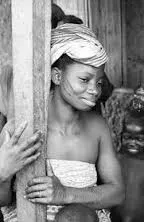The Yoruba tribe of Western Nigeria had a custom that was widespread hundreds of years ago of drawing their Ila (tribal/facial mark). Ila are distinctive markings made on a person’s face or body soon after birth or during childhood. People with this mark are known as Okola.
While the reasons for applying these marks vary, they may be done for aesthetic purposes, to identify a specific group of Yorubas, to identify slaves, to immunize newborns against diseases, or to carry out certain traditional rites, like keeping abiku (children who are destined to die repeatedly) alive (Ila Abiku). The Ila Abiku is vividly painted on the child’s body in order to cause his or her spirit friends to reject him or her whenever they attempt to come back.
In some families, the first son must have tribal markings while other children may be spared because of family customs.

Ila is marked using one of two techniques in Yorubaland: cutting the skin with sharp objects like knives, blades, or even glass in some cases. The first technique involves burning the skin with hot objects. The second technique is the more popular one.
Tribal Mark of Yoruba.
Every Yoruba tribe has a distinctive way of making marks, which can take many different forms and appear in various places on the body or face. The tribe’s culture or the reason for the marks determines the location and pattern of the mark.
Using the Ogbomosho clan as a case study, draw a thick and long vertical line on either side of the nose and extend it down to the mouth. The Ondo natives draw a series of deep, straight, and curved lines on both sides of the face and call them Gombo or Keke. Additionally, the Ijesas are well-known for their “Pele,” a four-line tribal mark that is drawn on both sides of the cheeks. There are several variations of “Pele,” including Pele Ijesa and Ijebu, which are brief horizontal lines drawn on the cheeks, Pele Ife, which is unique to the Akoko people of Ondo, and Pele Akoko.
The Abaja mark, also referred to as “Abaja Alafin Mefa,” is another type of tribal marking found in Yorubaland. It consists of six horizontal lines inscribed on both sides of the cheeks. The current Alaafin of Oyo, Oba Lamidi Adeyemi III, has a face with the Abaja style, which is typical of the Oyo people. Jamgbadi, Mande, Ture, Bamu, and other variations of Ila are also available.
Tribal mark types.
The Yoruba people hold the view that the origin of the tribal mark can be traced to a particular period when the king of Oyo, Sango, sent two of his slaves on an expedition to a distant land. Sango discovered that only one of the slaves had succeeded in his task, and the other had failed, when the slaves had returned. The second slave was given 102 cuts with a razor all over his body while the first slave was rewarded. The scars on the slave’s body healed after his punishment and sufferings, giving him an admirable appearance that attracted the king’s wives, who asked to have the cuts made on their bodies as well. When Sango saw this, he declared that rather than being used as a form of punishment, the cuts should be given to people as a sign of royalty. Sango chose to get the cuts, but he could only take two on his arm. Since that time, getting the cuts has become a sign of royalty.

It is not surprising that this long-standing custom has started to fade in contemporary Yoruba society as civilization and modernity have made it clear how dangerous it is to have tribal markings.
“The practice of tribal marks should stop because it is a violation on an individual’s fundamental right,” said Bamidele Oluwaseun (President, NAMACOS, AAUA), who spoke on the subject. A person with tribal marks is additionally susceptible to infection because various items that might be contaminated with germs are applied to the mark’s surface. If I had tribal tattoos on my face, I would feel distinct from other people and isolate myself from my peers. “.
Here is a different interview that Ifa Priestess Omitonade Ifawemimo conducted with an interviewer regarding the same subject of tribal marks.
Do you believe that using a tribal mark violates a person’s right to free speech?
Omitonade Ifawemimo: In the modern era, yes. The child did not have the mental capacity to decide whether he or she wanted it at the time those marks were made, which is why. However, as of right now, it is an infringement on his rights. If he were to grow up and choose it, there would be no issue.
Interviewer: Should the practice of tribal marking end, and if so, why?
Omitonade Ifawemimo: You know tribal marks are a part of Yoruba culture and traditions, so don’t respond. Alafin Sango was the first tribal member to use marks as a form of punishment; later, they evolved into symbols of identity and beauty.
Interviewer: If you have tribal marks on your face, are you going to be proud of them or will you feel differently?
Omitonade Ifawemimo: Possibly funny.
The CEO of Ancestral Vision Arts and Crafts, Omitonade Ifawemimo, is an Ifa priestess.
Comment below with your thoughts on whether tribal marking should continue or cease.

